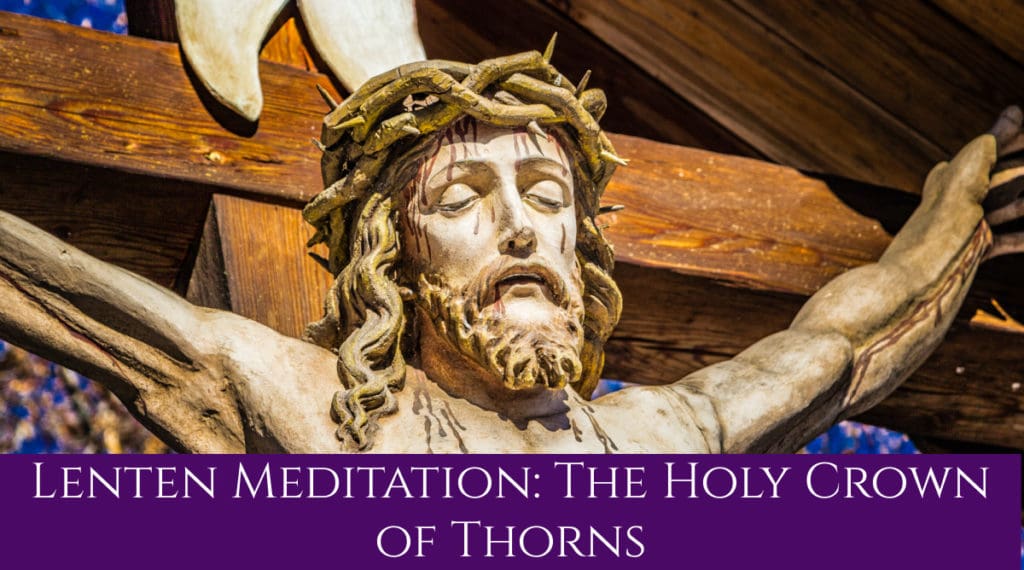Author’s Introduction: This is the fourth of a series of meditations based on the Lenten Votive Masses of the Passion of Jesus that have been prayed throughout the history of the Church in various usages. Some have their origin in early medieval times and were used in various places in Europe and in particular religious orders. Some can be found in the 1955 and 1962 editions of the Missale Romanum. Some parallel prayers can be found in the current English edition of the Roman Missal as well as the Missal of the Holy Land. These meditations are given to offer us an old yet new way to enter into the Passion of Jesus and the salvation He offers us that is rooted in scripture, tradition, and history of the Church. May praying with and reflecting on them help you to grow in Divine Intimacy with Our Lord Jesus and His saving graces this Lenten season and whenever you enter into prayer.
The text of this mass can be found here.
Opening Collect: Grant, we beseech You, almighty God, that we who for remembrance of the passion of our Lord Jesus Christ reverence His Crown of thorns on earth may deserve to be crowned with glory and honor in heaven by Him Who lives and reigns with You in the unity of the Holy Spirit, God forever and ever.
The crown of a king or a queen is one of the most noticeable symbols throughout human history, representing the majesty of their office’s authority, vocation, and mission given to them by God. Crowns were also worn in Ancient Jewish times by the bridegroom on their wedding day, as also seen in the crowning of the Bride and Groom in the wedding rites of the Eastern Catholic and Eastern Orthodox Churches. The Crown is not only a symbol of authority and office, but it represents the binding of the lives of the bride and groom to each other in love even unto death. The crown of thorns and the cross of Jesus shows me the union between spousal love, truth, and authority that Jesus wishes to show in the life of His church and every believer.
We see Our Lord Jesus in his passion after being scourged by the Roman soldiers, clothed in a purple robe, handed a reed, and having a crown of thorns placed upon his head. (Cf. Matthew 23:27-29; Mark 15:16-19; Luke 22:11; John 19:1-5) These items are given to Jesus in mockery of his identity as Messiah, Son of God, and the King of Israel. The crown of thorns conveys something about the authentic identity and mission of Jesus, the Church, and every disciple.
In the lesson of the mass (Song of Songs 3:7-8), an interesting scene is described: “Behold, sixty valiant ones of the most valiant of Israel, surrounded the bed of Solomon, All holding swords, and most expert in war: every man’s sword upon his thigh, because of fears in the night.” Who are these sixty valiant ones who surround King Solomon’s bed, the place where he binds himself in love to his bride? They are the ones who guard him and his bride and act with his authority and in his name. They would be his guard, twice as many as his father King David had (2 Sm 23:8-39). (Arminjon, The Cantata of Love, Song of Songs 3:7, 204) Jesus as the New Solomon definitively fulfills this promise both in the paschal mystery and in the life of the Church extends to our present age. The entourage of the valiant men surrounding the bed of Solomon is seen in the example of the successors of the apostles seen in the presence of the saintly popes, bishops, priests, doctors, saints, and directors, who “with discretion and sacred wisdom, watch over the good of those souls entrusted to them, always ready to defend them with the sharp spiritual sword of the true word of God, elucidated, by their example.” (Juan Arintero, Song of Songs: A Mystical Exposition, 3:7, 327)
How the faithful long for this protection in every age of the Church’s life, especially in our age! How do we long for priests who are true pastors and spiritual fathers! They are the ones who lovingly form, nourish, challenge, and defend them with the sword of the gospel. They guard against “fears in the night,” which represents the reality of sin and evil that seeks to pervert and destroy her ranks. These men, who are the sixty valiant ones, represent the ideal of the priesthood. They are not just administrators who seek worldly comfort and success at the cost of souls. They are fathers who are present and espoused to Christ and His bride. They are priests who live lives of humble, faithful integrity despite their own weakness and sin. They seek to live the faith they preach with their lips with the deeds of their lives, and their willingness to shed their blood for the salvation of souls. The pastors are the ones who are called first to guard the bed of the new Solomon that is His Church in faith, hope, love, holiness, and humble integrity. When these virtues are lacking, then there is a temptation to dominate and compromise the deposit of faith for worldly gain and esteem thus scattering the flock of Jesus. (Cf. Jer 10:21 & 23:1-3, John 10:8)
We see this ideal of the sixty valiant ones of King Solomon contrasted against the group of the soldiers of the Roman Legion who pay Jesus mock honors by calling him a king (Gospel of the Mass – John 19:1-3). In their insincerity, ridicule, and blasphemy, they ironically point to the truth of who Jesus is by doing three things two him: 1) they place a mock crown on his head, 2) then they give him mock clothing to wear, 3) and bestow on him mock acclamations (Thomas Aquinas, Commentary on John, C 19, L 1 n. 2374). Saint Thomas Aquinas speaks about how it was customary for a king to wear a crown of Gold in the ancient world. (cf. Sir 45:12; Ps 21:3) By the crown of thorns, Jesus removes the thorns of sin, which pain us through remorse of conscience. (cf. Jer 4:3) He also takes away the thorns of punishment that burden us (Gen 3:18) (Commentary on John, C. 19, L 1 n. 2375). The purple tunic with the crown that Jesus wears is reminiscent of the royal dignity and honor bestowed upon the Roman Emperor (Cf. 1 Macc 8:14). It also indicates the sufferings of the Suffering Servant as well as those of the martyrs, “which stains red the entire body of Christ, that is, the Church. (Commentary on John, C 19, L 1, n 2376.) They mock him by saying “Hail, King of the Jews!” in the common address to their king. This shows a complete lack of respect to his person and his kingship. Aquinas also notes that this implicates mystically “those greet Christ mockingly who profess him with words but deny him with their deeds. (Cf. Titus 1:16; Matt 7:21) (Commentary on John, C. 19, L 1 n. 2377)
The throne of King Solomon is referenced (Song of Songs 3:9-11), and the daughters of Jerusalem are urged to Go forth towards it. This throne would be contrasted with both the throne of Christ the King, his cross (cf. Introit of Mass, Song of Songs 3:11):
King Solomon has made him a litter [throne] of the wood of Lebanon: The pillars thereof he made of silver, the seat of gold, the going up of purple: the midst he covered with charity for the daughters of Jerusalem. Go forth, you daughters of Sion, and see king Solomon in the diadem, wherewith his mother crowned him in the day of his espousals, and in the day of the joy of his heart.
The ornamentation of a king’s throne had important symbolism in the Ancient world. It represented his authority, power, and might. The throne of Jesus from which he reigns is his cross which in the ancient world of the Roman Empire was one of the most horrible ways to die. Jesus takes the ultimate sign of death and transforms it into the throne by which he conquers sin, death, and satan through love and binds himself to his wayward bride for whom he lays down his life.
In the early Church, there was a hesitancy, at first, to depict Our Lord Jesus Crucified in art. This was because so many Christians were executed at the hands of the Romans through crucifixion. After the legalization of Christianity in the Roman Empire and during the Middle Ages, one would see then the rise of the depiction of Jesus Christ crucified in liturgical art. Often the cross would be heavily ornamented with gems and fine metals in the manner as the throne of King Solomon is depicted. Such liturgical ornamentation represented the offering of one’s life that every believer is called to make before the cross in prayer and the presence of Jesus in the Eucharist at every mass before receiving him. Jesus pours out his blood for me and endures mocking and ridicule in love for him. The least I can do is offer the gems and diamonds of my life – what is most valuable to me despite their finite nature so that he can transform them into a place where His glory and new life are seen.
When I adorn Jesus with my love and my brokenness, he can transform me into a saint by His grace – a living mystery of the presence of He who is the Divine Bridegroom of my soul. He then adorns me in this worship with his own life and dispositions (Song of Songs 4:11; Isaiah 61:10-11). Mary shows this same gesture with the anointing of the feet of Jesus with oil and the brushing of his feet with her hair while at Bethany. (Cf. John 12:3) The life of faith is never just about my own agenda or making an ideal earthly utopia of my own making. I follow Jesus in His Church to enter into the love of Divine Union and share that love between us with others, especially the poor and forgotten. Without the total gift of self-made in worship through sacraments and daily prayer, I risk then becoming like the soldiers who mocked Jesus or Judas who betrayed him. We pray then for the grace and faith to go out to behold Christ our King and His great love for us amidst his passion and death. We also pray that as he offers himself entirely amidst pain, mockery, and death in his passion, we may be given the grace to offer our lives anew in our goodness and brokenness as consolation that adorns him. In doing so, may we be crowned ever more deeply with His love and salvation that he offers us through his passion, death, and resurrection (Cf. Song of Songs 4:11).
Opening Collect: Grant, we beseech You, almighty God, that we who for remembrance of the passion of our Lord Jesus Christ reverence His Crown of thorns on earth may deserve to be crowned with glory and honor in heaven by Him Who lives and reigns with You in the unity of the Holy Spirit, God forever and ever.
Image credit: Deposit Photos.




